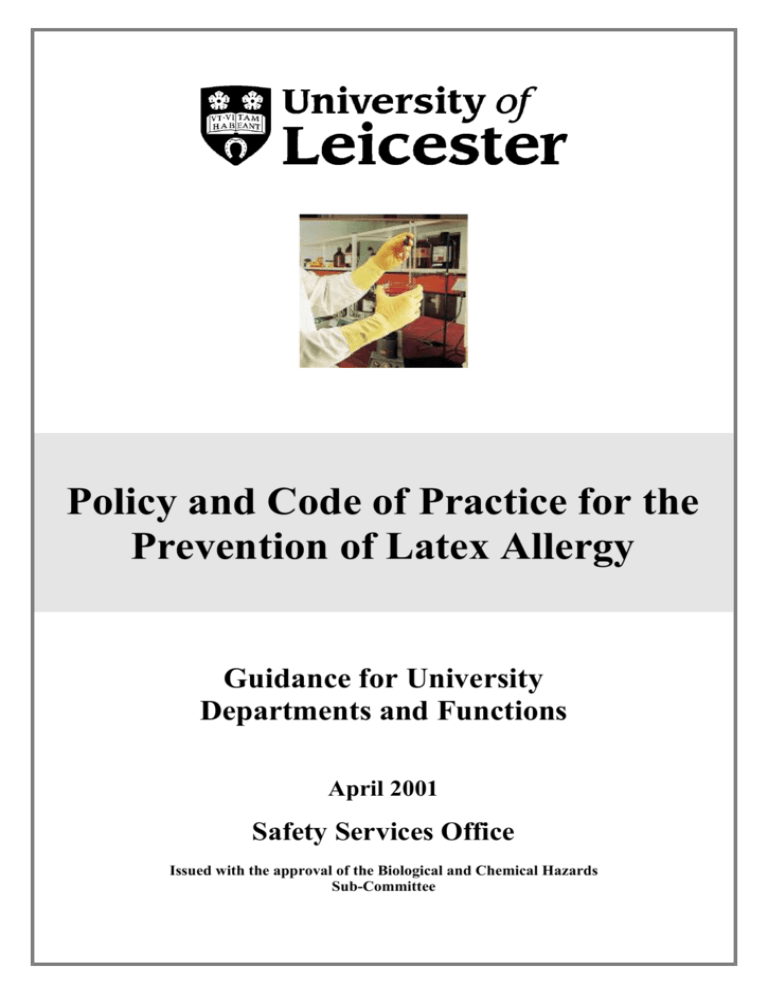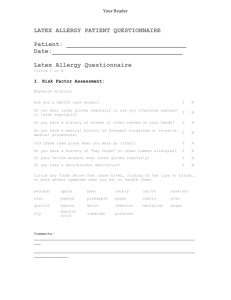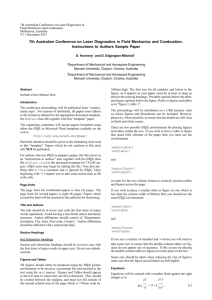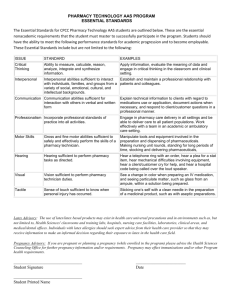POLICY FOR THE PREVENTION OF LATEX ALLERGY
advertisement

Policy and Code of Practice for the Prevention of Latex Allergy Guidance for University Departments and Functions April 2001 Safety Services Office Issued with the approval of the Biological and Chemical Hazards Sub-Committee POLICY AND CODE OF PRACTICE FOR THE PREVENTION OF LATEX ALLERGY Introduction Latex allergy is an increasing problem in healthcare and laboratory workers as a result of the greatly increased use of latex gloves in recent years. This increase has been largely due to the need for protection against blood-borne viruses, and the need to protect work from contamination e.g. in molecular biology laboratories. Latex is a milky fluid produced by many plant species. The latex referred to here is natural rubber latex (NRL) from the sap of the Hevea brasiliensis rubber tree found in Africa and South East Asia. This latex is used to manufacture a vast range of goods from car tyres and toys to medical devices. To date, twelve proteins from latex have been registered as allergens with the WHO. Latex gloves also contain potentially allergenic chemical additives required during processing and to prolong shelf life. In addition, they may be powdered with modified maize starch, which adsorbs allergens and carries them into the air. Powdered latex gloves therefore constitute a greater hazard. Health problems associated with the use of latex gloves are: Irritant contact dermatitis, a non-immune reaction characterised by dry, crusty, hard bumps and cracks appearing on the skin 48 to 72 hours after contact. This is not an allergic condition. It can be associated with soaps and detergents, glove powders and the occlusion caused by glove wear. Only the area of skin that has been in contact with the glove is affected. Delayed hypersensitivity or allergic contact dermatitis, a type IV cell-mediated allergic reaction typically caused by chemical accelerators (e.g. thiurams) used during the glove manufacturing process. Symptoms include a red rash, bumps, sores and cracks and occur from several hours to several days after contact. The affected area of skin may extend beyond the area in contact with the glove. Immediate sensitivity, a type I IgE-mediated allergic reaction to one or more of the latex proteins. Symptoms range from immediate contact urticaria (weal and flare reaction, itchy rash and eczema) to runny eyes and nose, breathing difficulties, swelling of eyelids, lips and face and life-threatening anaphylaxis. On contact with any natural rubber latex product, sensitised individuals are at risk of severe reactions, comparable to those with nut allergy. Powder from latex gloves presents a particular hazard, as where these are used there is a high risk of allergen inhalation. The majority of hand rashes among health care and laboratory workers are irritant, not allergic. The incidence of allergy is difficult to quantify but current estimates are that it occurs in about 8-12% of those regularly exposed. Atopic individuals, those with spina bifida and those with allergies to certain fruits (such as avocados, tomatoes, bananas, chestnuts and kiwi fruits) are at increased risk. Sensitised individuals have to avoid any contact with latex products, not only at work but in their daily lives – even balloons used as decorations at a party can trigger symptoms. An individual with 1 Type I allergy to latex who undergoes medical or surgical procedures is at serious risk of life-threatening anaphylaxis if contact with latex occurs (there are thousands of medical devices which contain NRL apart from gloves.) Several such cases have been reported in the literature. Between 1988 and 1992 the Food and Drugs Administration in the USA received reports of more than 1,000 systemic allergic reactions to latex, 15 of which were fatal. In one American study, out of 350 employees of Mayo Medical Centre, Rochester whose clinical histories and laboratory findings indicated sensitisation to latex, 77% reported contact urticaria, over 50% experienced allergic rhinitis, conjunctivitis or asthma, and 16 episodes of latex-induced anaphylaxis were documented in 12 employees. Further information about latex allergy and guidance on glove selection can be found in the University of Leicester documents “Glove selection guide” and “Information on latex allergy and its prevention”1, available from the Safety Services Office. Latex is a substance hazardous to health under the Control of Substances Hazardous to Health Regulations 1999; therefore the University is obliged to take steps to control these risks to its staff. The following is the University’s policy on prevention of latex allergy. 1) Scope of this policy This policy covers the non-clinical use of protective gloves in all Departments of the University, including those sited within the University Hospitals of Leicester. Use of gloves in clinical settings is covered by the Leicester General Hospitals NHS Trust Latex Allergy Policy and Guidance. 2) Reduction of exposure a) Curbing inappropriate use For many jobs disposable latex gloves are not the best choice. Indiscriminate use of latex gloves must be curbed. All laboratory staff must have access to the University of Leicester documents “Glove selection guide” and “Information on latex allergy and its prevention”2. Supervisors and research group leaders must encourage staff to choose non-latex gloves where appropriate. Suitable alternatives in many cases include vinyl and nitrile. These must be made available when their use is indicated. Non-Departmental staff (e.g. cleaners) must not be allowed to use laboratory stocks of gloves. b) Selection of low-allergen latex gloves i) Powdered latex gloves will not be used. ii) Where the use of latex gloves is indicated (e.g. when human blood or other tissues are being handled), non-powdered gloves with a low extractable protein content (less than 50 micrograms/gram) must be used. c) Glove liners Glove liners (e.g. cotton or nylon) should be made available to staff on request. 1 2 In preparation In preparation 2 3) Training and information The problem of latex allergy must be discussed with new staff during induction training. Staff should be asked about any previous history of latex allergy, any other allergy, or any skin problems especially if associated with glove use. If there are any grounds for suspicion of latex allergy the member of staff must be referred to the Occupational Health Service for clinical evaluation. Existing staff must be informed about the risks. Copies of the HSE leaflet “Latex and You” must be kept in each Department and must be available for staff to read. All staff must be told to keep vigilant for signs of sensitisation, such as asthma or the sudden appearance of rashes on the hands or forearms. 4) Purchasing a) Powdered latex gloves will not be kept in bulk stores. b) Stocks of non-latex gloves, such as nitrile and PVC, must be kept. c) Before purchasing non-powdered latex gloves, the extractable protein content of the gloves must be ascertained in writing from the supplier and only those with less than 50 mg/g must be purchased. The Safety Services Office can assist. 5) Action on discovery of suspected latex allergy a) If actual or possible latex allergy presents, the staff member must discontinue using latex gloves immediately and must be referred to the Occupational Health Service. The Safety Services Office must be informed immediately. b) If the Occupational Health Physician considers that the patient may be sensitised to latex, allergy testing must be carried out. If confirmed, the case is reportable under the Reporting of Injuries, Diseases and Dangerous Occurrences Regulations 1995. 6) Responsibilities a) Heads of Department i) have overall responsibility for enacting this Policy in their Departments ii) must ensure that sufficient time and resources (such as induction training time) are allocated to do so. b) Supervisors, Chief Technicians and research group leaders i) will ensure that all staff who report to them, or whose work they direct or control, are sufficiently informed to make the correct choice of protective gloves ii) must ensure that all workers who report to them, or whose work they direct or control, keep vigilant for any kind of health problem associated with the use of protective gloves iii) must report any reported health problem associated with the use of protective gloves to the Safety Services Office and to their Head of Department. c) The Safety Services Office i) will make available up-to-date information on latex allergy ii) will keep records of any reported health problem associated with the use of protective gloves iii) will report confirmed cases of latex allergy to HSE under the Reporting of Injuries, Diseases and Dangerous Occurrences Regulations 1995 3 iv) will give advice to any member of staff on request. d) The Occupational Health Service i) based on clinical judgement, will arrange for latex allergy testing of patients referred with suspected latex allergy ii) may, at their discretion, report a confirmed case to the MDA as an Adverse Incident. e) All members of staff i) will abide by Departmental procedures laid down to enact this Policy ii) will keep vigilant for signs of sensitisation or irritation, and report any symptoms immediately. 4






